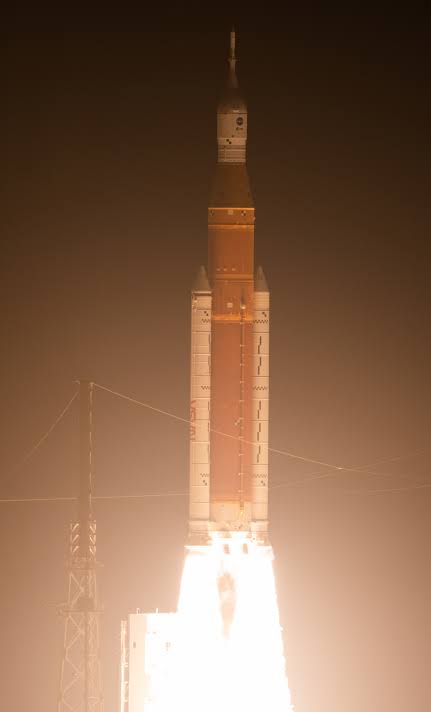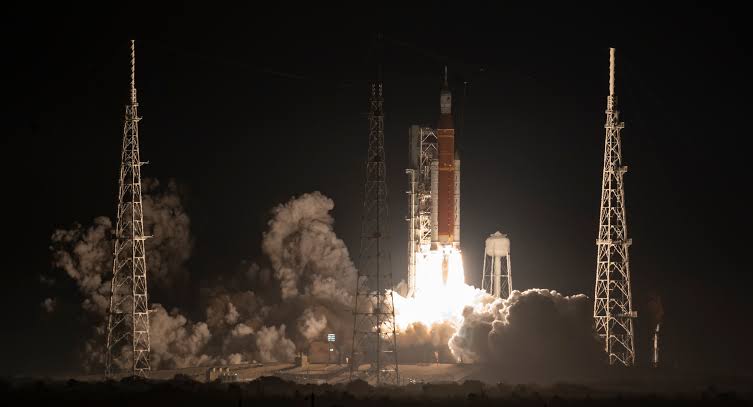As part of the Artemis I program, NASA’s Orion spacecraft is currently en route to the Moon following the successful launch of the Space Launch System (SLS), the most potent rocket in the world. SLS launched from Launch Pad 39B at NASA’s Kennedy Space Center in Florida at 1:47 a.m. EST on Wednesday to conduct its first flight test.
The launch is the first step in a mission that will see Orion leave Earth and travel 40,000 miles beyond the Moon before returning in 25.5 days. The mission, known as Artemis I, is an important component of NASA’s Moon to Mars exploration strategy, which emphasises exploration for the benefit of humanity. Before sending astronauts on the Artemis II mission, it is a crucial test for the organization.
Related: NASA’s Artemis I Moon Rocket Ready To Lift Off On Nov 16: Live Updates

“What a breathtaking sight it was to watch the Orion spacecraft and NASA’s Space Launch System rocket launch together for the first time. As we get ready for manned exploration of the Moon and, eventually, Mars, this uncrewed flight test will test Orion to its absolute limits in the rigors of deep space,” according to NASA Administrator Bill Nelson.
The Deployment Of Solar Arrays
Orion’s solar arrays were deployed once it reached its initial orbit, and engineers started checking out the spacecraft’s systems. The rocket’s upper stage engine successfully fired for roughly 18 minutes about 1.5 hours into the flight to give Orion the powerful thrust it required to send it out of Earth orbit and toward the Moon.
Orion has disengaged from its upper stage and is now traveling to the Moon using the assistance of its service module, which was developed by the ESA (European Space Agency) as part of an international partnership.
Where Is Orion Headed?
According to Jim Free, NASA’s deputy associate administrator for the Exploration Systems Development Mission Directorate, “Orion is currently on its path to the Moon after a long journey to get here.” Because of this successful launch, NASA and our partners will be able to travel farther than ever before in orbit for the benefit of humanity.
The CubrSats
Ten tiny CubeSats, or small satellites for science and technology, will launch from a ring that connects the upper stage to the spacecraft throughout the course of the following several hours.
Each CubeSat has a unique mission that may help close knowledge gaps about the solar system or showcase technology that could be used for designing missions to investigate the Moon and other celestial bodies in the future.
About eight hours after launch, Orion’s service module will also carry out the first of several burns to maintain Orion’s direction toward the Moon.
Mission controllers at NASA’s Johnson Space Center in Houston will perform any additional checkouts and course corrections that are required over the next few days.
The Orions Next Steps
On November 21, Orion is anticipated to fly by the Moon, making a close approach to the lunar surface en route to a far-off retrograde orbit that is thousands of miles beyond the Moon and is a highly stable orbit.
Mike Sarafin, the mission manager for Artemis I, stated that the Space Launch System rocket “provided the power and performance to send Orion on its route to the Moon.” “With the completion of the mission’s first significant milestone, Orion will now move on to the next phase to test its systems and get ready for further missions with astronauts.”
Problems Before The Launch
On Nov. 4, the Orion spacecraft and SLS rocket arrived at Kennedy’s Launch Pad 39B where they survived Hurricane Nicole. After the storm, teams carefully examined the rocket, spacecraft, and related ground systems to make sure there had been no significant effects from the bad weather.
Prior to Hurricane Ian, on September 26, engineers rolled the rocket back to the Vehicle Assembly Building (VAB) after rejecting two previous launch attempts on August 29 and September 4 respectively due to faulty temperature sensors and a liquid hydrogen leak at an interface between the rocket and mobile launcher.
Teams successfully fixed the leak and demonstrated new tanking techniques before rolling back to the VAB. Teams carried out routine maintenance while within the VAB to fix minor damage to the foam and cork on the thermal protection system and to recharge or swap out all of the system’s batteries.
Conclusion
Thousands of people from all over the world are contributing to Artemis I, including small businesses that are providing subsystems and components and international and university partners. These individuals include contractors who built Orion and SLS and the ground infrastructure required to launch them.
The first woman and the first person of colour will touch down on the Moon through NASA’s Artemis missions, opening the door for a sustained lunar presence and acting as a stepping stone for astronauts travelling to Mars.
